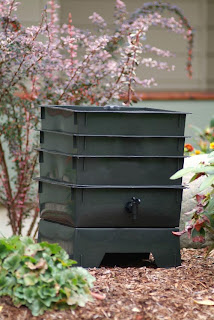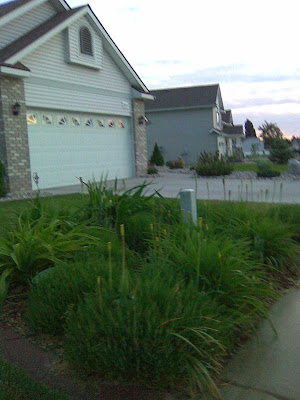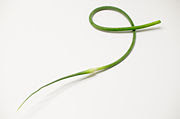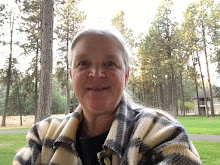
Now that the gardening season has run its course, most gardeners are kicking back and thinking the end of summer means the end of the garden. But, if you have decided that you want to make a go of gardening organically you must know that fall is not the time to get lazy.
Fall is the best time for planting your trees, shrubs and perennials with the long winter months providing the down time needed for building a healthy root system. Plus, fall is the most important time to be working on improving your soil.
If you are serious about going organic then you have to get the nutrients into the soil that the chemicals would normally provide and add the organic matter that sets the stage for healthy root growth.
Fall's chore list can be long, but the benefits go way beyond much of what you do during the hot summer months or the cold wet days of spring. If you do your work in fall you have winter to do much of your work for you.
There are three things you should concentrate on adding to you soil this time of year:
- raw organic matter
- organic nutrients
- finished compost
RAW ORGANIC MATTER
Unless you live where your weather allows you to garden year around your garden will lay fallow through the winter months. If you do garden year around then you should be allowing a portion of your garden to lay fallow in order to build up the soil between plantings.
By adding raw organic matter to your soil you feed all the beneficial bacteria and fungi that live in your healthy soil. These beneficials are a big part of your success in your organic garden. These beneficial organisms will need nitrogen to do their work and would benefit from an addition of a nitrogen source to help them function properly. A good source of natural nitrogen comes from animal manure. Fall is a great time to add manure to your soil. You don't have to worry about the manure burning anything as "O'man Winter" takes care of everything. See my post on animal manures titled "The Scoop on Poop" posted on 5/15/07 for valuable information on manures. If you don't have a ready supply of any type of manure available you can use granular organic fertilizer. This is a good one to choose:

All-Purpose Fertilizer, 25 Lbs.
Shredded leaves are at the top of the list for good additions to the soil in fall. It's the time of year when leaves are readily available and they break down to provide valuable humus. Use a shredder if you have one or mow over them with your lawnmower to break them up.
ORGANIC NUTRIENTS
Nutrients from an organic source are not immediately available as with chemicals. This is why you need to add them to your soil in the fall, so the nutrients will be available next spring. Again, you are feeding the beneficial organisms with each addition to your soil. Kelp meal, greensand, soft rock phosphate, alfalfa meal, feather meal or bone meal are all good sources of organic nutrients. Many of these are also an excellent nitrogen source. Follow the instructions on the package for application rates. Sometimes a little will go a long way and more is not always better. It's all about balance of nutrients.
It's a good idea to do a soil test to determine the pH of your soil. Fall is a good time to adjust the pH so it happens slowly over time. If your pH is not in optimum levels for the plants you want to grow then it won't matter that the nutrients are there, the plant cannot utilize them.
FINISHED COMPOST
If your compost bin, be it conventional or a worm bin, is not producing a large amount of quality, finished compost it is worth purchasing what you need to supplement it. Also, understand that your worm compost is different from conventional compost. A quality worm compost has a wide variety of beneficial organisms that will compliment the soil food web you support with your soil ammendments.
Purchasing a truckload of quality compost might seem like over-kill. But do it once and you'll never go through another fall without it. Store it on a large tarp to keep the area neat and keep it covered to keep it from getting soggy in the fall rains. The tubtrug is a great garden helper when it comes to getting compost where you need it. With it's bright colors it's easy to spot no matter where you leave it.

Colorful Tubtrug
As you remove the garden debris from your beds use a garden fork to work up the top soil down about 6" and work in a 3"-4" layer of compost.
Flower beds also need compost. As you cut back your perennials in preparation for winter work compost into the soil around the root zone. As you remove your annuals and plant new bulbs add compost as you work.
And as you plant your trees and shrubs, a few shovels full of compost added to the soil that goes back into the hole is a good idea.
BETTER SOIL = BETTER GARDEN
By building your soil you are arming it with what it needs to help retain water, support healthy root systems, and help your plants fend off disease and pests. Building better soil is the single most important thing you can do to help guarantee success in your garden.
So get out of that hammock and off the patio and get to work on next years garden.
Success,
Christy
Mother Earth's Farm / VermiCulture Northwest
Worm Factory
The cleanest, most efficient way to compost with worms.
www.vermiculturenorthwest.com



 The other is a more traditional solution, to interplant the bulb with a late arrival in the garden. Plant with a perennial that is slow to wake up in the spring and somewhat slow to get started to give the bulb time to replensh itself before it is shaded out by the perennial.
The other is a more traditional solution, to interplant the bulb with a late arrival in the garden. Plant with a perennial that is slow to wake up in the spring and somewhat slow to get started to give the bulb time to replensh itself before it is shaded out by the perennial.












